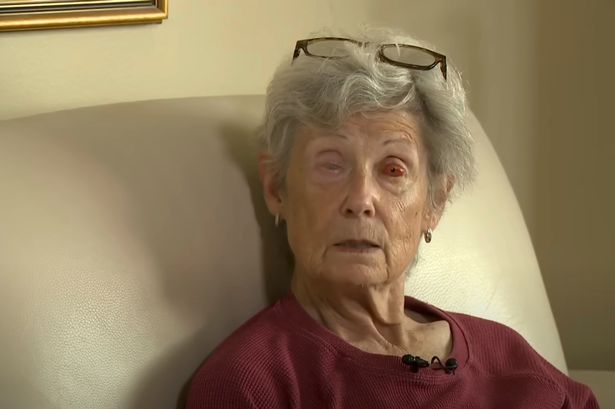Health
Canadian Woman Regains Sight Through Innovative Tooth Implant Surgery

A groundbreaking surgical procedure has allowed a blind woman in Canada to regain her sight after ten years of darkness. Gail Lane, a 75-year-old resident of Victoria, British Columbia, underwent an innovative operation in February 2024 that involved implanting a tooth into her eye to restore vision affected by an autoimmune disorder.
The surgery, known as osteo-odonto keratoprosthesis (OOKP), is often referred to as the “tooth-in-eye” procedure. It is designed for patients with severely damaged corneas who cannot benefit from traditional corneal transplants. Lane’s journey began after her condition scarred her corneas, leaving her unable to see for a decade. With the hope of regaining her vision, she became one of the first three individuals to undergo this rare surgery in Canada.
Innovative Procedure Details
The OOKP surgery consists of a two-part operation. Initially, a tooth is extracted and meticulously prepared. The tooth is sliced lengthwise and polished to create a smooth plate, then a hole is drilled into it for the insertion of a prosthetic cornea. This combined structure, known as an OOKP, is implanted into the patient’s cheek for three months, allowing connective tissue and blood vessels to form. This step is crucial for ensuring the body accepts the implant once it is later stitched into the eye socket.
According to the National Health Service (NHS), “Osteo-odonto-keratoprosthesis (OOKP) is a technique used to replace damaged corneae in blind patients for whom cadaveric corneal transplantation is not an option.” Originally developed in Italy about 40 years ago, this complex procedure is only considered in cases of end-stage corneal disease when other treatments have failed.
Life-Changing Results
After the surgery, Lane experienced a gradual return of her vision. Initially, she could distinguish between light and dark, but over time, her vision improved significantly. She was thrilled to see movements, including the tail of her partner’s service dog, Piper. “I can see lots of colour and I can see outside now,” she shared with CBC News. “It’s a wonderful feeling to be able to see some of those things again.”
Six months after the operation, Lane had the emotional experience of seeing her partner for the first time. She expressed excitement about being able to recognize facial features of others, although she has not yet seen her own reflection. Lane hopes that new glasses will help her achieve this milestone.
The pioneering surgery in Canada was led by Dr. Greg Moloney from Mount Saint Joseph Hospital in Vancouver. He described the procedure as “complex and strange,” emphasizing that the tooth serves a vital role in enhancing the likelihood of a successful outcome. “We need a structure that is strong enough to hold onto the plastic focusing telescope, but is not going to be rejected by the body,” he explained.
As OOKP surgery gains recognition, it marks a significant step forward in providing hope and restoring vision to those with limited options. For individuals like Gail Lane, this remarkable procedure has transformed their lives, allowing them to reconnect with the world visually after years of blindness.
-

 Health2 months ago
Health2 months agoNeurologist Warns Excessive Use of Supplements Can Harm Brain
-

 Health2 months ago
Health2 months agoFiona Phillips’ Husband Shares Heartfelt Update on Her Alzheimer’s Journey
-

 Science2 weeks ago
Science2 weeks agoBrian Cox Addresses Claims of Alien Probe in 3I/ATLAS Discovery
-

 Science2 weeks ago
Science2 weeks agoNASA Investigates Unusual Comet 3I/ATLAS; New Findings Emerge
-

 Science2 weeks ago
Science2 weeks agoScientists Examine 3I/ATLAS: Alien Artifact or Cosmic Oddity?
-

 Entertainment4 months ago
Entertainment4 months agoKerry Katona Discusses Future Baby Plans and Brian McFadden’s Wedding
-

 Science1 week ago
Science1 week agoNASA Investigates Speedy Object 3I/ATLAS, Sparking Speculation
-

 World2 months ago
World2 months agoCole Palmer’s Cryptic Message to Kobbie Mainoo Following Loan Talks
-

 Entertainment3 months ago
Entertainment3 months agoEmmerdale Faces Tension as Dylan and April’s Lives Hang in the Balance
-

 Science1 week ago
Science1 week agoNASA Scientists Explore Origins of 3I/ATLAS, a Fast-Moving Visitor
-

 Entertainment4 months ago
Entertainment4 months agoLove Island Star Toni Laite’s Mother Expresses Disappointment Over Coupling Decision
-

 Entertainment2 months ago
Entertainment2 months agoMajor Cast Changes at Coronation Street: Exits and Returns in 2025









